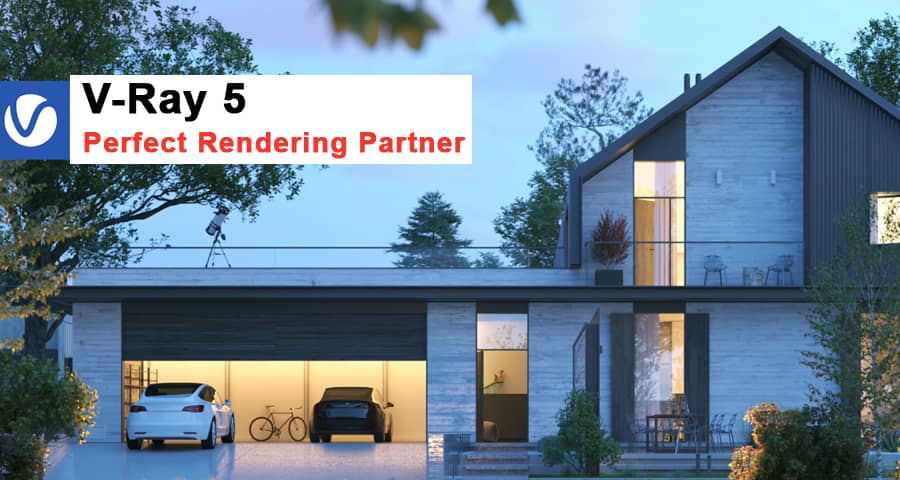If you are a SketchUp user and need to render your designs and are in search of an ideal rendering plugin for SketchUp then V-Ray 5 is your answer to all your solutions.
With V-Ray’s robust engine, you will be able to take your 3D models from idea to production, enabling you to light them globally, add interior and exterior lighting, render them along lines, add textures and materials, create atmospheric effects, apply reflective coatings, and so much more. In addition, you will also be able to render in real-time if you use V-Ray Vision, which is another great feature.
V-Ray 5
The new V-Ray 5 offers both real-time and photoreal rendering options in V-Ray 5, allowing you to create a complete rendering package that includes everything an architect, engineer, or construction professional needs for real-time and photoreal renderings.
In order to tell a convincing visual story, rendering needs to be able to convey the essence of the story visually. Removing any uncertainty around your design, the materials used, and the aesthetic intent of your project closes the gap between stakeholders as well as improves communication between them.
It is clear how your idea fits into the surrounding environment, what materials it is built of, and how it will seem whether illuminated by the sun or shrouded in fog.
For each step of your project, you can choose the right rendering technique with V-Ray: conceptual, interactive, and real-time renderings to gain internal support; quick renders to compare design possibilities; or photorealistic views to heighten anticipation for the finished product.
Features of V-Ray 5
Powerful & photo-realistic rendering solutions
If you are in need of a powerful and photorealistic 3D rendering extension for SketchUp then V-ray 5 is your solution. Through a live link with SketchUp, you will be able to explore your SketchUp models with an interactive game-like environment where you can render your models instantly and access alternative viewports.
Real-time rendering allows you to swiftly show concepts to customers, make changes as you go, and work remotely with your team, significantly cutting down on project turnaround times. When you’re finished, simply click a button to take screenshots, export animations, and create spherical panoramic photos for virtual reality.
3D library with ready-made models
Utilize V-extensive, Ray’s web-based content library, which is full of high-quality, intelligent 3D content that you can download straight into your design, to save time and modeling effort.
These render-ready elements can be seen as rasterized objects in V-Ray Vision, high-resolution ray-traced objects in V-Ray 5, and low-resolution polygons in the SketchUp viewport to improve model performance.
Exterior layout
Whether it is designing a structure, a large project, or a landscape, your ability to obtain buy-in, and communicate your genuine intentions, can be enhanced by including architectural surroundings, architectural materials, textures, lighting, atmospheric effects, and volumetric effects in your models.
When it comes to communicating your ideas, it is best to start with a real-time rendering and end with a photorealistic rendering as soon as possible without making to bit complicated. The rendering of SketchUp models with V-Ray provides polish and realism to any model, no matter how small or large.
Interiors decoration
By using V-Ray rendering, you can combine natural light sources with artificial light sources, so that you can show how daylight and interior lighting are going to change the appearance of the space.
Then you can further customize your rendering with various additional objects, materials, and textures that you can add to make it even more unique.
Commercial space designing
With aspects like visual displays, lighting, flow, and spatial design leaving little to no room for mistakes building up a retail space may be expensive.
The rendering process can be used to visualize your thoughts, fine-tune them, and finish them before moving on to the actual development process. V-Ray Vision allows you to make adjustments in real-time to your renderings as you go, enabling you to discover any problems early on with high-quality renderings.
Making animations
Quality animation and fly-through can help facilitate the communication of your narrative at any stage in the design process. You should use animations when presenting your bids and competitions to impress your potential clients, as a little bit of animation will also enhance your presentation skills.
You might also consider generating interest and excitement for commercial properties during the final stages of the design process. Use real-time rendered panoramas to immerse stakeholders in the design process, as well as 360-degree photorealistic images to support virtual reality viewing.


